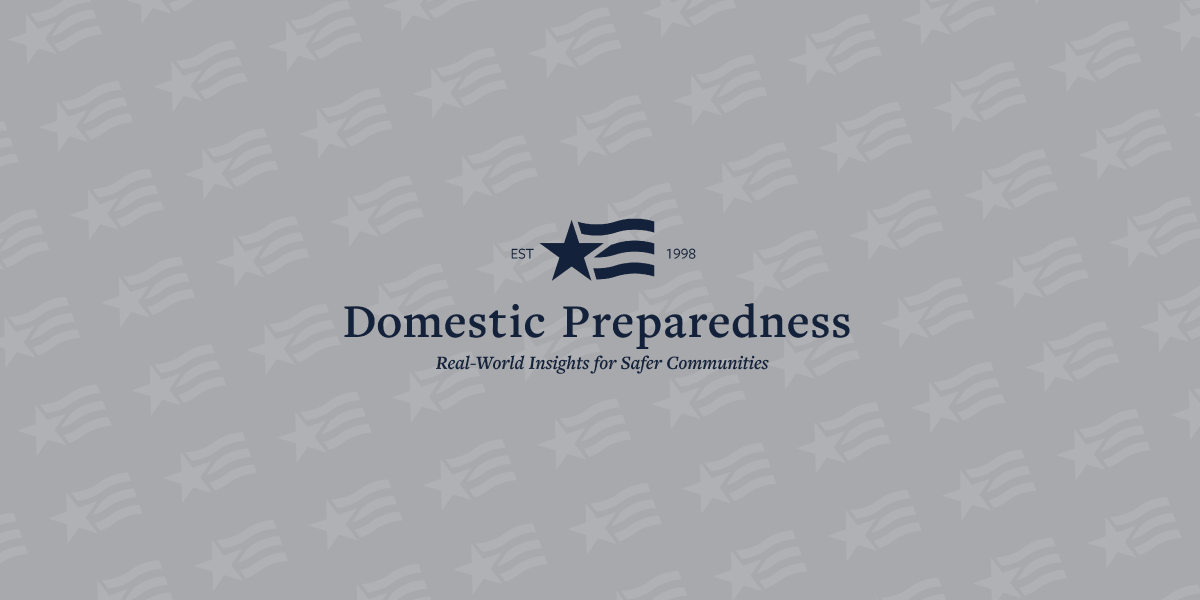Hurricanes Irene, Katrina, and Ike, the floods of the Mississippi and Cumberland rivers, the Joplin and Tuscaloosa tornados, the Minneapolis bridge collapse, the Northeast Blackout, the Deep Horizon oil spill, and, of course, the terrorist attacks on 11 September 2001 – all of these major disasters underscore the value of providing and improving resilience and security on a metropolitan regional scale. In that context, the term “region,” as used here, refers to a metropolitan region – defined by the U.S. Census Bureau as “a geographic entity containing a core area of at least 100,000 persons plus adjacent communities having a high degree of social and economic integration with that core.”
At the core of any region’s resilience and security capabilities and resources are its critical infrastructures, its core public services, and its economic base – which include but are not necessarily limited to such tangible and intangible resources as water and wastewater, energy, transportation, telecommunications and cyber systems, public health and safety, state and local governments, banking and major industries, healthcare, food, and shelter.
The numerous dependencies within and between infrastructure systems – services, business, and economic sectors – affect not only societal wellbeing but also the ability of communities within a region to rebound from potentially catastrophic events.entifying and addressing these dependencies can prevent a series of “cascading” failures that can quickly compound and exacerbate the negative effects of a natural or manmade disaster. Dealing effectively with these dependencies usually requires, therefore, a uniquely regional approach wherein larger systems converge and work together to serve the greatest number of people. This is not an easy task, because the interlocking dependencies are almost always extremely complex, and dealing effectively with disasters becomes – again, almost always – an immediately high priority.
Two Decades of Continuing But Sometimes Halting Progress
The vital role played by interdependent infrastructures has been understood since the early 1990s, but practical tools have yet to be developed to: (a) systematically assess the levels of security and resilience of infrastructures within a specific region; and (b) evaluate the numerous options available for enhancing their security and resilience. An objective, quantitative process is therefore needed forentifying and evaluating the various ways that regions can enhance security and resilience – within the limits of the financial and human resources available. To ensure that the results of a quantitative process are used in the practical world, such a process should, at a minimum: (a) fit integrally with the budget process of the public and private organizations that make infrastructure decisions; and (b) produce results that are directly comparable with infrastructure investment proposals for purposes other than security and resilience.
These budget processes are themselves in need of reform, particularly in the field of public infrastructures. As pointed out in a 27 March 2006 report, Guiding Principles for Strengthening America’s Infrastructure, “We are both under-investing in infrastructure and investing in the wrong projects: new investments are critically needed, but we lack the policy structures to make correct choices and investments [emphasis in original].” Adding to both the credibility and urgency of that report, which was issued by the Center for Strategic & International Studies, is the fact that it was written, edited, and otherwise “vetted” by an expert team that included a number of sitting and former state governors, U.S. senators, and nationally recognized experts in infrastructure investment from areas throughout the country.
On 11 October 2010, the White House’s three-member Council of Economic Advisers prepared, in cooperation with the U.S. Department of the Treasury, a complementary report, An Economic Analysis of Infrastructure Investment, which concluded that “Federal funding for infrastructure investments is not distributed … using rigorous economic analysis or cost-benefit comparisons. … The [current] process virtually assures that the distribution of investment … is suboptimal from the standpoint of raising national productive capacity.” It is now obvious, partly because of that review, that there is a compelling need to develop a more rigorous analytic process for infrastructure investment that includes the added value to economic productivity, as well as improved security and resilience, that might reasonably be expected.
The Business Process – Its “Most Critical Components”
Last year, the Infrastructure and Geophysical Division of the U.S. Department of Homeland Security’s Science and Technology Directorate sponsored the Regional Resilience/Security Analysis Process (RR/SAP) to meet this challenge. ASME Innovative Technologies – working in close cooperation with a team from The Brashear Group LLC, the Alion Science and Technology Corporation, Virginia Tech University, and The George Washington University – developed and tested the initial RR/SAP design, which is largely based on concepts and tools developed since 2002.
Among the most critical components of RR/SAP, which have been in development and testing stages since that same year, are: first-hand experience in nine infrastructure sectors and subsections; three national standards; four regions ranging in population size from 50,000 to several million people (the National Capital Region, Hampton Roads and Danville, Virginia, and Nashville-Davidson County, Tennessee); and numerous and varied regional disasters. The feasibility of RR/SAP also has been tested and assessed by key stakeholders (regional leaders, managers, operations and engineering personnel of critical infrastructure systems, core community services, and key elements of the business base) at all levels of government and industry, and has proved to be practical, reliable, and useful for supporting difficult public and private decisions.
Basically, RR/SAP consists of two cycles of analysis: (a) a baseline risk/resilience assessment cycle to quantify the primary risk and resilience challenges to a specific region (and its infrastructures and critical public functions); followed by (b) an option evaluation cycle to estimate the value of the specific options proposed and/or available for enhancing productivity, resilience, and security.
Six Phases, Numerous Variables, and Alternative Solutions
Both cycles follow the same six analytical phases, wherein the assessment cycle estimates current risk and resilience conditions – and the evaluation cycle estimates how, and how much, the proposed options would improve these conditions. The principal differences, usually, are the benefits expected from the various options available. The six tasks (illustrated in the accompanying figure) are carried out in the following order:
1. Decision-makers define and rank objectives, criteria, metrics, and priorities for productivity, resilience, continuity, security, and other factors. In the first cycle (risk/resilience assessment), these are developed through a rigorous paired-comparison process (called the Analytical Hierarch Process – a carefully structured method for ranking objectives and alternatives that has become widely used in the military, private industry, and even player selection in the National Football League). In the second cycle (mitigation option evaluation), the initial objectives may be refined, but the primary emphasis is setting priorities for developing the options needed to enhance resilience and security.
2. Key facilities and their assets undergo a static in-depth, confidential risk/resilience analysis using an all-hazards, all-quantitative American National Standard Institute (ANSI)/American Water Works Association Standard No. J100-10, Risk and Resilience Management of Water and Wastewater Systems, 2010 approach. That approach uses methods consistent with the Department of Homeland Security’s own National Infrastructure Protection Plan wherein risk is a function of threat likelihood, vulnerability, and consequences – resilience is a function of service outage severity and duration, and there is the same vulnerability and threat likelihood. In the first cycle, the current risk and resilience are estimated. In the second, the risk and resilience that would exist if the options were implemented are factored into the equation; the difference is considered to be the “gross benefit” of the option.
3. Service delivery systems operating under current configuration and control systems are modeled, using a systems-dynamics approach to refine the owners’ estimates in a dynamic analysis that captures the effects of the system’s ability to cope with emergencies. This analysis alsoentifies the specific geographical locations of outages – a critical factor inentifying and understanding where other infrastructures may be impacted.
4. Various dependencies among the systems are analyzed using a combined-systems dynamics model to determine where one system’s difficulties might adversely impact other systems’ operations, quantifying direct dependency risks and resilience issues for other owners as well as for the region as a whole.
5. Estimated service outages and shortages are analyzed using a regional input-output economic model to estimate the total economic impact – including “ripple effects” and multipliers – on the regional, state, and possibly national levels. This model also estimates the impacts on revenue and output of each major industry sector in the region as well as the probable regional impacts on jobs, wages, and local tax collections.
6. Decision-makers review the results. In situations where the baseline assessment cycle’s results are unacceptable, the option evaluation cycle defines a range of new capabilities, projects, programs, and/or investments that might be needed, and used, to enhance productivity, resilience, continuity, and security; these possibilities usually are analyzed by revisiting all of the preceding analytical phases to estimate the possible ways in which (and the extent to which) the programs and investments required will generateentifiable improvements (expected benefits) and the associated capital and operating costs involved. The benefits and costs are estimated from the perspectives of both the owners of the respective systems and of the region’s public. The respective decision-makers will review these evaluations to determine which (if any) should be included in their own budgets and operational plans.

The Distinguishing Features of RR/SAP
RR/SAP is designed to exhibit several highly desirable features, including the following operational virtues and capabilities:
- Being technically sound, quantitative, objective, and repeatable;
- Possessing estimated values relevant and related to decision-makers’ objectives, risks, resilience, benefits, and costs in terms that are directly comparable and consistent throughout – and directly comparable as well to other, unrelated, investment options, to support budget and program decision-making;
- The ability to report decision-relevant results from the perspectives of each – the owners and the regional community, respectively – using data based on the common “physics” of specific threats to specific assets and their physical impacts;
- The complementary ability both to estimate risk/resilience vulnerabilities and to incorporate the likelihood of unwanted events and the various additional vulnerabilities that might be associated with each;
- Inclusion of the explicit effects of dependencies and interdependencies both on owners and on the region as a whole – along with a supporting analysis of how best to limit/mitigate such effects;
- The capability of being carried out and maintained by on-site, non-specialized, non-expert staff; and
- The inherent ability to permit periodic re-analyses, over a certain period of time, for accountability and progress measurements.
Rollout, Results, and Recapitulation
RR/SAP has already been demonstrated to be feasible, but requires additional development and testing to bring it to its full potential to rationalize infrastructure investment. These refinements could be carried out in a combined testing-development-enhancement program by any of several entities. Major metropolitan regions could adopt RR/SAP, for example, as the operational vehicle needed to rationalize and vindicate their own infrastructure investments. Jurisdictional issues in some metro areas might reasonably suggest that states initiate and manage the process – or establish multi-jurisdictional authorities to do so.
RR/SAP also could serve as the basis and foundation of a national “bottom-up” program to use risk analysis to increase the preparedness, value, security, and resilience of infrastructures, to stimulate self-help and local determination, and/or to include as an indispensable element of federal grant programs – maintaining a set of highly comparable regional assessments by which national progress could be measured.
In similar fashion, related efforts by user communities and cross-regional information sharing could help spread innovative options and develop best practices models. The 2011 Presidential Policy Directive (PPD-8) on National Preparedness issued by President Barack Obama mandates risk-informed, decision-making for “all-of-nation” resilience and security; RR/SAP could and probably should be, therefore, evolved into an ongoing standardized process linking newly integrated homeland-security grants programs. Or it could become a service and/or integrated service-product offering provided by a forward-looking technology or consulting firm.
Whatever else happens, the results of the refinement and widespread use of this revolutionary new business process will be: (a) rational, public-private collaboration toward local-preference, risk-analysis-based priorities; and (b) future investments that make regional infrastructure systems and community facilities more valuable, resilient, secure, and reliable – and, in aggregate, create a more productive, resilient, secure nation that is able to protect all of its citizens, businesses, and society as a whole.
____________
For additional information on: The Center for Strategic & International Studies’ “Guiding Principles for Strengthening America’s Infrastructure,” visit https://web.archive.org/web/20100206220042/http://csis.org/files/media/csis/pubs/060327_infrastructure_principles.pdf
The White House report “An Economic Analysis of Infrastructure Investment,” visit https://web.archive.org/web/20110206000245/http://www.whitehouse.gov/sites/default/files/infrastructure_investment_report.pdf
The American Water Works Association Standard J100-10, visit http://apps.awwa.org/WaterLibrary/ShowAbstract.aspx?an=0072080
The Southeast Region Research Initiative, visit

Jerry P. Brashear
Jerry P. Brashear, Ph.D., is the managing director of The Brashear Group LLC. He is a researcher and consultant on infrastructure risk/resilience policy, analysis, and management processes. He has led risk consulting and R&D programs at ICF Consulting, The University of Texas at Austin, George Mason University, the American Society of Mechanical Engineers, and The Brashear Group LLC to advance the practice of infrastructure and regional risk/resilience analytic methods and processes. He consults to senior management in infrastructure and homeland security agencies and on infrastructure services at all levels in the United States and internationally. He holds degrees from Princeton, the Harvard Business School, and the University of Michigan.
- Jerry P. Brashearhttps://domesticpreparedness.com/author/jerry-p-brashear






